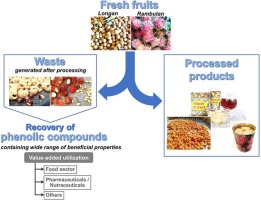Journal of Functional Foods ( IF 3.8 ) Pub Date : 2020-02-21 , DOI: 10.1016/j.jff.2020.103846 Kanyasiri Rakariyatham , Dayong Zhou , Nuansri Rakariyatham , Fereidoon Shahidi

|
A large quantity of by-products is annually produced from processing of Sapindaceae fruits including longan and rambutan, accounting for 24.9–40.7 and 52.9–74.7% of the whole fruit on a fresh weight basis, respectively, and these are currently discarded. These by-products are rich in phenolics with over 50 compounds identified. Among these the main components are gallic acid, ellagic acid, corilagin, and geraniin. This review highlights the biological activities, health-promoting effects and safety evaluation of these by-products as well as their potential application in food and pharmaceutical industries. In addition, comparison of the advantages and disadvantages of conventional and modern extraction techniques for the recovery of these phenolics are discussed. This information is intended to inspire further research in areas that are still underexplored and encourage fruit processing manufacturers to find ways to add value to these fruit by-products and to minimize their wastage.
中文翻译:

pin科(龙眼和mo)种子和果皮的副产品:酚类化合物的潜在来源,并在食品和健康应用中用作功能成分
Sapindaceae水果(包括龙眼和红毛丹)的加工每年产生大量副产品,按鲜重计分别占整个水果的24.9–40.7和52.9–74.7%,目前已将其丢弃。这些副产物富含酚类,已鉴定出50多种化合物。其中的主要成分是没食子酸,鞣花酸,可乐可宁和香叶素。这篇综述重点介绍了这些副产物的生物活性,促进健康的作用和安全性评估,以及它们在食品和制药行业中的潜在应用。此外,还讨论了常规和现代萃取技术回收这些酚类的优缺点的比较。











































 京公网安备 11010802027423号
京公网安备 11010802027423号